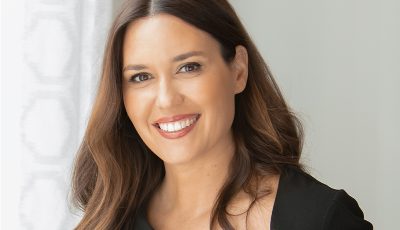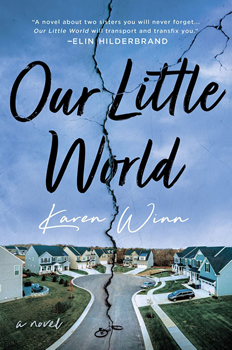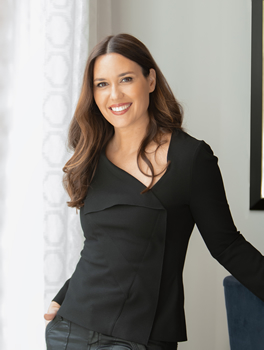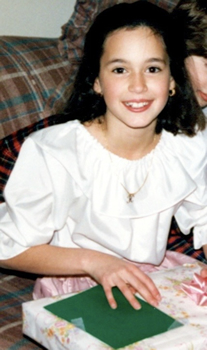

Up Close: Karen Winn
Examining the Complexities of Relationships
 By Dawn Ius
By Dawn Ius
Karen Winn’s interest in examining the complexities of relationships provided the spark for her debut novel, OUR LITTLE WORLD, an unforgettable coming-of-age story complicated by tragedy, death, and sisterhood.
In it, soon-to-be seventh-grader Bee is anxious to get her summer started—a season of chasing fireflies around her cul-de-sac with the neighborhood kids, especially Max, the boy who just moved in across the street. But for Bee, it’s not all sunshine and flowers. She struggles to “match up” to her younger sister, Audrina, who seems to dazzle wherever she goes.
Her sister’s seemingly flawless exterior, along with Bee’s dreams of a perfect summer, changes, though, when Max’s little sister goes missing at a nearby lake and the once close-knit community begins to separate under the strain of Sally’s disappearance. Suspicions arise, creating tension not only in the neighborhood, but in Bee and Audrina’s home as shameful secrets begin to surface. Bee and Audrina’s sisterhood is already fraught—could this be what tears them apart for good?
In this exclusive interview with The Big Thrill, author Karen Winn shares more about what inspired this story of envy, sisterhood, and how the traumas of our youth carry through to adulthood.
Though OUR LITTLE WORLD wouldn’t necessarily classify as a classic thriller, you’ve woven in some thrilling and suspenseful elements—including a tragic and untimely death. I’d love to hear more about the inspiration for this coming-of-age novel.
I was very much interested in examining the complexities of relationships—how and why they get tested. Using an idyllic childhood and setting (similar to the one I had) magnified the severity of the tragedies and allowed me to explore their deep repercussions. I got to find out the dirty secrets and bad decisions of the characters in this small town, which the unfortunate events brought to the surface.
It would be impossible not to comment on your chilling first paragraph, which really lures the reader in and sets the novel’s tone. In terms of writing process, is Chapter/Page/Paragraph 1 always your entry point, or is your journey far less linear?
Thank you. I wrote this novel chronologically, which is how I usually work. And, in fact, the writing of the prologue and first chapter flowed fairly easily, and during the writing of subsequent chapters, I would periodically reread the first few pages of my novel to recall the tone I wanted to continue to convey and carry throughout the novel.

Winn says she wrote OUR LITTLE WORLD chronologically and that “writing of the prologue and first chapter flowed fairly easily.”
Envy is a common motivator in all fiction, especially in thriller. OUR LITTLE WORLD explores this theme, along with the complicated bond of sisterhood and so much more. Aside from a compelling story, what do you hope readers take away from this book?
Life is not necessarily always fair, and the unspeakable can certainly happen, which I’ve seen as a nurse and which I’ve now inserted into my novel. I hope that readers take stock of the relationships they have with their loved ones and that they enjoy the small moments.
Sibling stories are trending in fiction right now—at least a third of the books we’re covering this month explore sisterhood. Why do you think these kinds of stories resonate with readers?
Even the best and closest relationships—of any kind—can have cracks, which people relate to and understand. Sisterhood, in particular, is a unique kind of relationship, with much love and intimacy, but also often with accompanying friction. As a writer, I find it fascinating to explore these fissures.
Both the setting—Hammend, New Jersey—and the time period in which the novel takes place—1985—seem vital to the story’s plot. What prompted these choices?
A seemingly safe small town in the ’80s was the perfect bubble with which to pierce with tragedy. It was before the worldwide web, so children didn’t have ready access to information and news. They had to wait to receive such information (or perhaps eavesdrop on their parents’ conversations), which naturally creates an element of suspense.
Hammend truly did feel as though it became its own character in the novel. What is your connection to the town, and what aspects of it were important for you to include?
Hammend is a fictionalized version—and anagram—of Mendham, NJ, the small, 5,000-person town where I grew up in the ’80s and ’90s. It was a bucolic setting, so the perfect place to draw inspiration from when creating the idyllic town in OUR LITTLE WORLD.
The already complex family dynamics portrayed in OUR LITTLE WORLD are further strained under the pressure of a missing child and family secrets. The Big Thrill is as much for aspiring writers as it is readers. What advice would you give writers looking to portray complex relationships?
I would say to look below the surface in relationships, what lies beneath. You will invariably find some darkness or troubling elements with which to poke and prod.
What can you share about what you’re working on next?
I’m working on another novel, this one set in present-day Boston. Similar to OUR LITTLE WORLD, it will explore complex relationships in the aftermath of a tragedy.
- On the Cover: Alisa Lynn Valdés - March 31, 2023
- On the Cover: Melissa Cassera - March 31, 2023
- Behind the Scenes: From Book to Netflix - March 31, 2023



